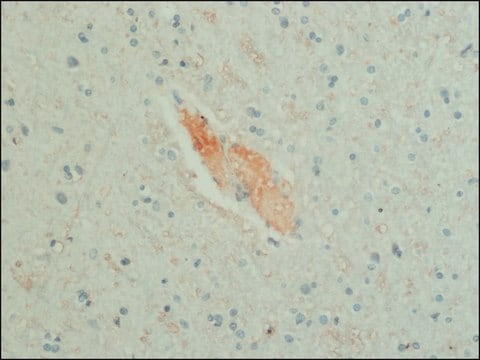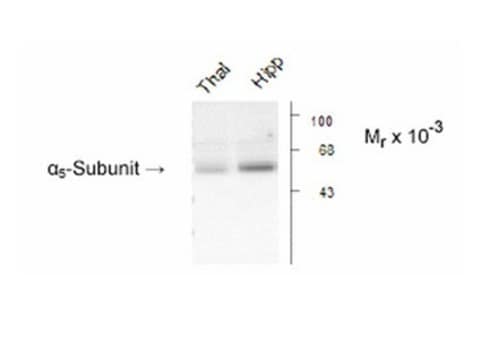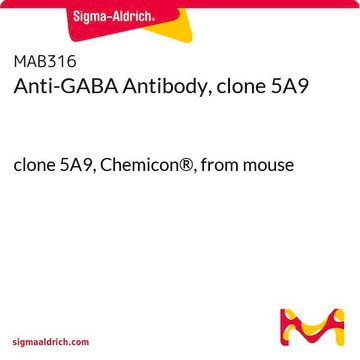AB175
Anti-GABA Antibody
serum, Chemicon®
Synonyme(s) :
Anti-GABA Receptor Antibody, GABA Receptor Antibody
About This Item
Produits recommandés
Source biologique
guinea pig
Niveau de qualité
Forme d'anticorps
serum
Type de produit anticorps
primary antibodies
Clone
polyclonal
Espèces réactives
rat
Réactivité de l'espèce (prédite par homologie)
all
Fabricant/nom de marque
Chemicon®
Technique(s)
ELISA: suitable
immunohistochemistry: suitable (paraffin)
Conditions d'expédition
dry ice
Modification post-traductionnelle de la cible
unmodified
Informations sur le gène
rat ... Gabra1(29705)
Description générale
Spécificité
Immunogène
Application
ELISA Analysis: A representative lot from an independent laboratory detected GABA in a competitive ELISA.
Immunohistochemistry Protocol:
Tissues fixed with 4% paraformaldehyde and 0-0.5% glutaraldehyde gives good results. Glutaraldehyde is required for antibody reactivity.
1) Tissue is fixed with 4% paraformaldehyde, 0-0.5% glutaraldehyde, 0.5% potassium dichromate in 0.1M phosphate buffer at pH 6.5.
2) Tissue is post-fixed overnight, vibratome sectioned in 50 mm and incubated in 0.05M Tris buffer, pH 6.5 for three hours.
3) Sections are incubated for 18-24 hours in AB175 diluted in PBS containing 0.1% sodium azide, 0.2% Triton X-100 and 1% normal goat serum.
4) Fluorescein conjugated antibody or ABC system may be used as the secondary reagent.
Note: Without colchicine pretreatment well-stained cell bodies are visible in the cerebral cortex, cerebrallar cortex, superior colliculus and some brainstem raphe. With colchicine pretreatment, additional cell body staining is present in the interpeduncular nucleus and the dorsal column nuclei.
Neuroscience
Neurotransmitters & Receptors
Qualité
Immunohistochemistry Analysis: A 1:500 dilution of this antibody detected GABA in rat brain tissue.
Forme physique
Stockage et stabilité
Handling Recommendations: Upon receipt and prior to removing the cap, centrifuge the vial and gently mix the solution. Aliquot into microcentrifuge tubes and store at -20°C. Avoid repeated freeze/thaw cycles, which may damage IgG and affect product performance.
Remarque sur l'analyse
Rat Brain tissue
Autres remarques
Informations légales
Clause de non-responsabilité
Not finding the right product?
Try our Outil de sélection de produits.
Code de la classe de stockage
12 - Non Combustible Liquids
Classe de danger pour l'eau (WGK)
WGK 1
Point d'éclair (°F)
Not applicable
Point d'éclair (°C)
Not applicable
Certificats d'analyse (COA)
Recherchez un Certificats d'analyse (COA) en saisissant le numéro de lot du produit. Les numéros de lot figurent sur l'étiquette du produit après les mots "Lot" ou "Batch".
Déjà en possession de ce produit ?
Retrouvez la documentation relative aux produits que vous avez récemment achetés dans la Bibliothèque de documents.
Notre équipe de scientifiques dispose d'une expérience dans tous les secteurs de la recherche, notamment en sciences de la vie, science des matériaux, synthèse chimique, chromatographie, analyse et dans de nombreux autres domaines..
Contacter notre Service technique








